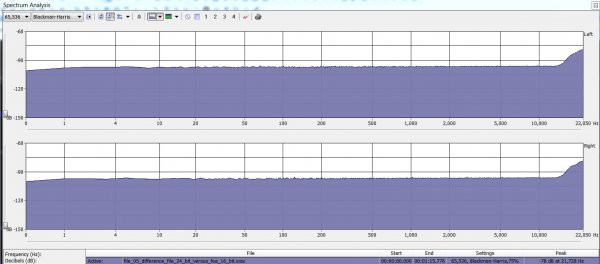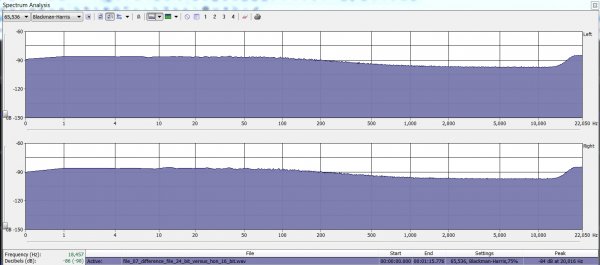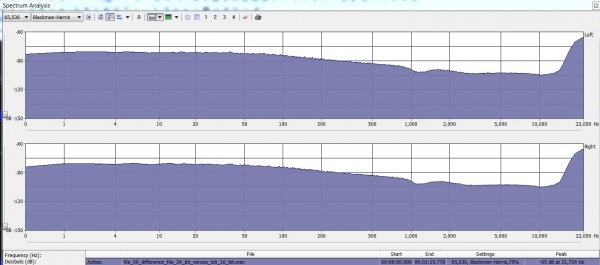Further to my post from yesterday, I am attaching some PCM files and some graphs to illustrate what I was writing about - how a mathematically perfect 16 bit digital noise floor will change the perception of the sound of musical content that itself never even remotely exceeds 16 bits of dynamic range (at best).
I have chosen a recent vinyl LP transcription that I made at 24/44.1 PCM on my digital audio workstation. The analogue to digital converter is specified at around 21 bits dynamic range and the recording bit depth was set to 24 bits. The recording is the recent Analogue Productions reissue of LSC6065 - the Ernest Ansermet Ballet recording remastered by Bernie Grundman - this is around one minute and 15 second's worth from the opening of side 1 (Tchaikovsky Nutcracker Suite March).
I deliberately chose this recording because of the "appalling" amount of noise that it possesses as compared to modern digital standards. It was made in the late 1950s - so not only do we have a 1/4 inch analogue open reel without even the benefits conferred by Dolby "A" noise reduction (it did not come into use until 8 years later), but we have all the additional noise from the entire recording and vinyl remastering chain and of course, all the additional noise produced by my own turntable and phono-pre amp. That is a heck of a lot of noise - WAY below what 16 bit is capable of. Infact at a guess, in terms of digital theory, I could have recorded this at a bit depth of around 11 or 12 bits and it ought to sound exactly the same as the 24 bit recording.
Note: all files are packaged in a 24 bit container as 24/44.1 files, regardless of the actual bit depth.
File 01: The first file is the "raw" 24 bit, 44.1 KHz master file as directly recorded by the workstation. The file name is "file_01_24_441_original.wav".
File 02: The second file is the "raw" 24 bit, 44.1 KHz master file as above, but truncated to 16 bits. In other words, I simply discarded the last 8 bits. The file name is "file_02_24_441_truncated_to_16_bits.wav"
File 03: The third file contains nothing more than the truncated bits 17 to 24 of the original 24 bit file (effectively file_01 minus file_02), then amplified by 40 dB. As you can hear for yourself, it consists of nothing more than hiss the whole way through. There is absolutely nothing audible whatsoever to suggest the original recorded content extends beyond 16 bits (infact it likely does not extend much beyond 11 or 12 bits). The file name is "file_03_truncated_bits_17_to_24_amplified_by_40dB.wav".
File 04: The fourth file is the original 24 bit (file_01) dithered to 16 bits using the first of three mathematically perfect 16 bit noise shaping "curves" available with the PSP X-Dither module - a module that I favour over all other dithering modules after many months of extensive comparative listening tests (as I can always find a setting that comes closer to the 24 bit original than using any other dither module I have ever tried). The file name is "file_04_16_441_with_foa_16_bit_noise_curve.wav".
File 05: The fifth file is the "difference" file between file_01 and file_04. Effectively it is the added 16 bits of quantisation noise in file_04. The file name is "file_05_difference_file_24_bit_versus_foa_16_bit.wav". Below is a graph showing this actual added quantisation noise in file_04. To state the obvious, this noise is completely and utterly inaudible when the musical content is playing. And even if I had the dither set to operate on silent sections (I don't), you'd have to turn the volume up to absolutely deafening levels to hear it in a normal listening room:
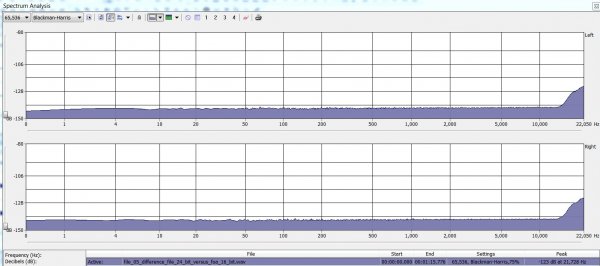 File 06
File 06: The sixth file is the original 24 bit (file_01) dithered to 16 bits using the second of three mathematically perfect 16 bit noise shaping "curves" available with the PSP X-Dither module. The file name is "file_06_16_441_with_hon_16_bit_noise_curve.wav".
File 07: The seventh file is the "difference" file between file_01 and file_06. Effectively it is the added 16 bits of quantisation noise in file_06. The file name is "file_06_difference_file_24_bit_versus_hon_16_bit.wav". Below is a graph showing this actual added quantisation noise in file_06. As with the previous example, this noise is completely and utterly inaudible when the musical content is playing:
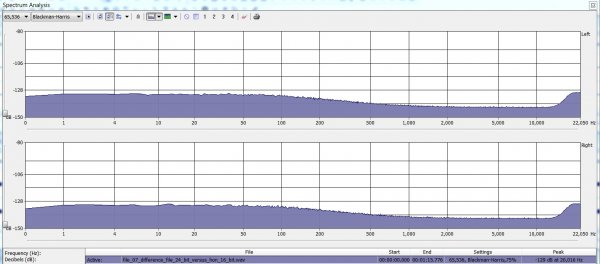 File 08
File 08: The eighth file is the original 24 bit (file_01) dithered to 16 bits using the third of three mathematically perfect 16 bit noise shaping "curves" available with the PSP X-Dither module. The file name is "file_08_16_441_with_lob_16_bit_noise_curve.wav".
File 09: The ninth and final file is the "difference" file between file_01 and file_08. Effectively it is the added 16 bits of quantisation noise in file_08. The file name is "file_08_difference_file_24_bit_versus_lob_16_bit.wav". Below is a graph showing this actual added quantisation noise in file_08. As with the previous examples, this noise is completely and utterly inaudible when the musical content is playing:
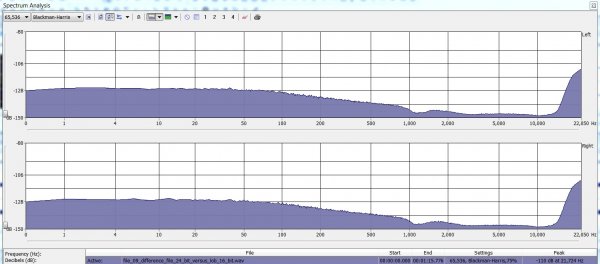
Below are the listening notes to guide you through the subjective listening tests - comparing the 24 bit original to the truncated version as well as the three different mathematically perfect 16 bit dithered files. Remember that according to digital audio textbook theory, all 5 of these files should sound identical because the original recorded source material would be lucky to exceed around 12 bits - far less than the "worst mathematically performing" of these files.
I won't make any comment about the original 24 bit file (file_01), since that is the "benchmark" file we are referring back to with each successive example. I would recommend that if you have difficulty hearing the differences amongst these files using normal A/B or ABXing, try instead listening to them in a normal listening situation over a period of a couple of weeks. As you become more and critical of what they actually sound like and much more acutely attuned to the nuances, you will almost certainly develop a preference for one (or even perhaps a couple) over the others. Of course, that should be the 24 bit one but in my experience, because noise shaping and dithering to 16 bits does change the sound during playback, sometimes the 16 bit versions can be subjectively preferable - or at least more "pleasant" (because the changed sound might subjectively "fix" or counteract a sonic weakness in the original or a sonic weakness in your own system or even your own hearing). That said, I've very rarely come across this sort of situation (I think I have seen it happen only a few times in over 220 analogue to digital conversions), but I thought I might mention it. If, for example, you had someone randomly label the files A, B, C and D, you might be surprised after a few weeks to find you like one of the 16 bit files better because the way in which they change the sound during playback synergises better with your system and your ears. To my ears, though, in this example the 24 bit example sounds the best and comes closest to the sound of the original analogue input. Of the 16 bit files, to my ears and on my system, the "FOA" version sounds the closest to the 24 bit version and is the one that I could happily with in long-term day to day listening (if I never had a 24 bit version of course). In other words, the shortcomings caused by the added quantisation noise might be noticeable in a direct comparison but when you have to live with the 16 bit version (for example, in the CD format) over the long term - weeks or months of familiarisation and critical listening - the FOA version is more listenable and the "damage" it causes to the 24 bit original is more benign. This version is - as a result - more sonically palatable and thus distracts less from one's listening pleasure.
Listening notes - truncated version (file_02)
First violins sound more metallic than in the 24 bit original. There is an artificial and edgy sheen to them that is absent in the 24 bit original. Soundstage is noticeably compressed compared to the 24 bit original - it sounds as if there are less string players in the first violin section even though the volume is of course precisely the same. The hall ambience is also compromised. In terms of pace, timing and coherency, however, I do not detect any especially significant difference between the two - it is mainly the steely edginess and compressed sense of 3D space that annoys me the most. But those two particular things annoy the heck out of me personally (especially as a retired amateur violinist) which is why I never truncate 24 bit files to 16 bit, even when recording from old analogue source material such as this.
Listening notes - FOA version (file_04)
Unlike the truncated version, this one retains much more of the original soundstage and the perception of each individual string player in first violin section, versus the compressed-sounding "player clumping" heard in the 24 bit version. The string tone is noticeably less edgy and steely and is more rounded compared to the truncated version - and for this reason it is far superior to mere truncation in my opinion. Where this version fails, however, is that the midrange gains some hardness and brittleness compared to the 24 bit version and there is a very small but perceptible loss of timing. Listen, for example, at between 16 and 19 seconds - the 24 bit version is smoother sounding and does not possess the brittleness of this 16 bit FOA version.
Listening notes - HON version (file_06)
To my ears, this version retains virtually all the timing of the 24 bit original. The compromises in this respect are exceptionally small and demand very critical listening. The price to pay here, however, is that the soundstage is not quite as good as with the FOA version above and that the midrange is noticeably spot-lit in the overall mix compared to the 24 bit original. Infact, if I did not know I had done nothing more than change the 16 bit noise shaping curve, I would have said someone had put a transistorised analogue equaliser to it and slightly emphasised the upper midrange.
Listening notes - LOB version (file_08)
This version has to my ears a fantastically clear and detailed midrange. You get virtually all the sense of the performing space and ambience of the original 24 bit version in the critical midrange where our ears are the most sensitive. But based on comparing the subjective listening notes to the graphs above, perhaps this should not be so surprising, since in this example, the signal to noise ratio is superb (for 16 bits) between 1,200 Hz and 12 KHz. And between 2,300 Hz and 12 KHz the signal to noise ratio exceeds the capability of the original analogue to digital converter used to make the recording in the first place. No wonder the midrange in this version sounds closest of all four to the 24 bit original. But there is a price to pay for this: The top end, whilst still significantly smoother sounding (and thus far more tolerable) than the truncated version (file_01), is emphasised in the overall mix over the 24 bit version. And the timbre of the violins also sounds thinned out compared to the 24 bit version. Compare, also, for the example, the thicker, rounder and woodier sounding timbre of the first violins in the FOA version versus the thinner timbre in this version. Furthermore, the bass is not quite as clear as that of the 24 bit original. Listen to the cellos playing the rising scale between 21 and 25 seconds for example - the 24 bit original possesses more clarity and "bite".
All the files can be downloaded as a "zip" archive from here:
https://www.sendspace.com/file/bhbkom











